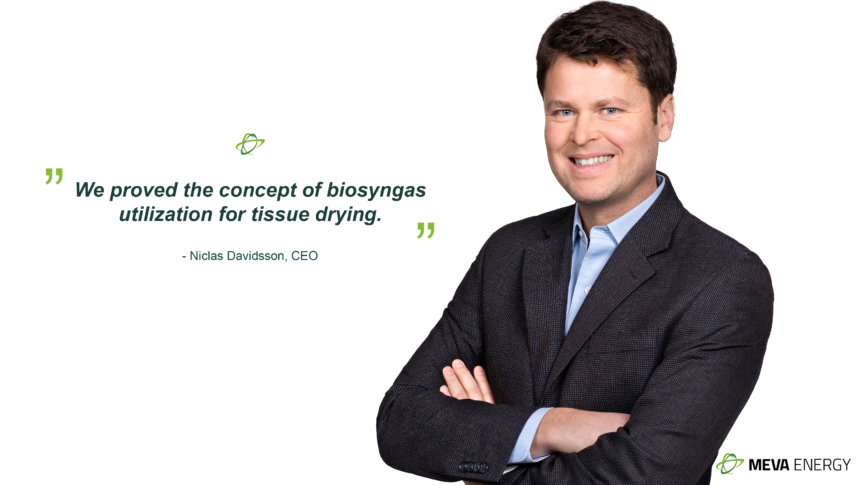At Meva Energy, 2023 was an intense year characterized by technological achievements and significants milestones. Niclas Davidsson, CEO at Meva Energy, shares his thoughts on Meva’s highlights and challenges in 2023 while providing an overview on what is to come next year.
The first time anyone even mentioned the concept of utilizing biosyngas for tissue drying was in 2016. It was proposed in a progressive scientific report and without knowing anything about the tissue industry, we were intrigued with it. Now, after a long period of prestudies, risk assessments, pilot trials and and interactions with suppliers and paper producing experts we have built the worlds´first facility for production of biosyngas to a tissue paper mill.
Last year was a very intense year for us with many highlights and milestones. Most importantly, we concluded the construction of our Kisa plant. Working together with Sofidel made a breakthrough in the way we dry tissue. We proved the concept of biosyngas utilization for tissue drying. Proving its effectiveness was a major milestone for us and it felt truly great to reach it as we had been working hard towards it for many years.
There have been a lot of lessons learnt too of course. From a technical point of view, we have had to make some adaptions of the process itself, mostly related to temperature control and water systems. There have also been many general learnings related to the corporate development. We experienced organizational growth in 2023. The additions of a new Chief Operating Officer (COO) and Chief Financial Officer (CFO) brought fresh perspectives and expertise, introducing a proper management team. The expansion wasn’t limited to the leadership team, as the headcount increased from 24 to 41, reflecting the company’s dedication to building a robust and talented workforce to develop our capabilities and capacity.
WHAT TO EXPECT IN 2024: KEY CHALLENGES AND OPPORTUNITIES
The world economy is still challenging and although interest rates have flattened out there is still hesitation towards large investments. Also, fossil gas prices have dropped which is challenging. Generally, the short-term business context is challenging. However, we do know that many prospective customers are following our increase in industrial maturity and we do think the future is bright.
At a more detailed level, we have a very important year ahead. We will accumulate more operational experience in the Kisa plant and improve on operational KPI´s. We will also start building our Zbaszynek plant with IKEA Industry in Poland. The SPV company has been set up and preparations for physical activities on site are under way.
Navigating a technology-based company in the energy sector sometimes calls for swift decision-making and the political factor is always present. But from our corporate perspective I am really looking forward to see our industrialization efforts pay off and to meet a lot of new customers.
BIOMASS GASIFICATION AS A AN IMPORTANT RESPONSE TO GLOBAL CHALLENGES
Biomass gasification is one of the largest still untapped sources of new renewable technology and one of very few alternative when it comes to replacing fossil hydrocarbons with biogenic energy in manufacturing industry. However it is also a relatively unknown technology for many energy stakeholders. I think that will change though, for several reasons. The first reason is the gradual understanding and acceptance of biochar as carbon sink. For several years, governments and the largest emitters have been focusing only on BECCS. There has been a lot of talks but not much action to be honest. Meanwhile, the biochar industry has grown on its own as a grass-root movement of relatively small companies. It is a really interesting story actually, how two CDR technologies can develop in two so fundamentally different ways. Anyway, ever since the IPCC considered to view also biochar as a necessary CDR technology the real interest from policy-makers started to pick up. Secondly, biosyngas is one of the most efficient ways to replace fossil hydrocarbons. Future technologies such as hydrogen and e-fuels may have gained a lot of interest for the potential, but in terms of production efficiency biomass gasification has a huge advantage. It is simply a technology which enables replacement fossil fuel with a minimum consumption of other resources including primary energy.

